Showing Spotlights 73 - 80 of 338 in category All (newest first):
 MXenes move nanotechnology from using a few 'wonder materials' to manipulation of hundreds and even thousands of 2D building blocks to assemble designer materials and devices. Those materials can contribute to solving the key problems in the fields of energy (generation, harvesting, storage), water (desalination, purification), food (longer storage, sensing of degradation/bacteria), environment (clean air and water) and medicine (treatment, diagnostics, artificial organs).
MXenes move nanotechnology from using a few 'wonder materials' to manipulation of hundreds and even thousands of 2D building blocks to assemble designer materials and devices. Those materials can contribute to solving the key problems in the fields of energy (generation, harvesting, storage), water (desalination, purification), food (longer storage, sensing of degradation/bacteria), environment (clean air and water) and medicine (treatment, diagnostics, artificial organs).
Jun 16th, 2021
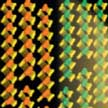 In general, there are three types of driving force for ion transport: electric field; mechanical pressure; and concentration gradient. Recently, light has been propsoed as a fourth. Now, researchers report the incorporation of a transition metal dichalcogenides based van der Waals multilayer heterostructure into nanofluidic materials, and demonstrate a new photo-induced active ion transport phenomenon. This will inspire a broad range of fundamental research and practical application for light-controlled ionic circuits, artificial photosynthesis, biomimetic energy conversion, and so on.
In general, there are three types of driving force for ion transport: electric field; mechanical pressure; and concentration gradient. Recently, light has been propsoed as a fourth. Now, researchers report the incorporation of a transition metal dichalcogenides based van der Waals multilayer heterostructure into nanofluidic materials, and demonstrate a new photo-induced active ion transport phenomenon. This will inspire a broad range of fundamental research and practical application for light-controlled ionic circuits, artificial photosynthesis, biomimetic energy conversion, and so on.
Mar 4th, 2021
 In order to exploit the remarkable mechanical properties of graphene for practical applications, nanoscale graphene sheets need to be assembled into much larger, macroscopic structures. However, there are two pivotal issues that make this task challenging: One is the inherently misaligned and wrinkled structure of graphene platelets; another is the weak interfacial interaction among graphene platelets. Both these problems greatly degrade the properties of macroscopic graphene assemblies such as sheets and fibers.
In order to exploit the remarkable mechanical properties of graphene for practical applications, nanoscale graphene sheets need to be assembled into much larger, macroscopic structures. However, there are two pivotal issues that make this task challenging: One is the inherently misaligned and wrinkled structure of graphene platelets; another is the weak interfacial interaction among graphene platelets. Both these problems greatly degrade the properties of macroscopic graphene assemblies such as sheets and fibers.
Feb 10th, 2021
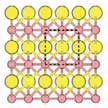 The industrial production of ammonia mostly relies on the energy-intensive Haber-Bosch process, which causes significant environmental pollution. Researchers have now proposed that a class of 2D transition metal borides termed MBenes - the boron-analogues of MXenes - could be used as catalyst for ammonia production through electrochemical nitrogen reduction reaction (NRR). This work also provides a general design principle for further exploration of an even broader composition space of MBenes and other 2D NRR electrocatalysts.
The industrial production of ammonia mostly relies on the energy-intensive Haber-Bosch process, which causes significant environmental pollution. Researchers have now proposed that a class of 2D transition metal borides termed MBenes - the boron-analogues of MXenes - could be used as catalyst for ammonia production through electrochemical nitrogen reduction reaction (NRR). This work also provides a general design principle for further exploration of an even broader composition space of MBenes and other 2D NRR electrocatalysts.
Nov 17th, 2020
 The use of graphene-based materials in pharmaceutical nanotechnology has recently received more attention due to their unique chemical structure and physicochemical properties - including an ultra-high surface area, optical, thermal and electrical conductivities, and a good biocompatibility. They can also load large amounts of drug molecules on both sides of the single atom layer sheet. The next generation of cancer nanotheranostics employing graphene-based nanomaterials could address the many challenges associated with traditional chemotherapeutic agents, such as the issues surrounding poor solubility, harmful side effects, non-specific drug distribution, and multi-drug resistance.
The use of graphene-based materials in pharmaceutical nanotechnology has recently received more attention due to their unique chemical structure and physicochemical properties - including an ultra-high surface area, optical, thermal and electrical conductivities, and a good biocompatibility. They can also load large amounts of drug molecules on both sides of the single atom layer sheet. The next generation of cancer nanotheranostics employing graphene-based nanomaterials could address the many challenges associated with traditional chemotherapeutic agents, such as the issues surrounding poor solubility, harmful side effects, non-specific drug distribution, and multi-drug resistance.
Oct 9th, 2020
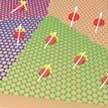 Researchers demonstrate that single-grain growth of graphene crystals can be achieved over a large, macroscale, area. Specifically, the team shows that graphene flakes, nucleated over a polycrystalline graphene film, synchronize during growth so as to ultimately yield a common crystal orientation at the macroscale. The phenomenon of self-alignment of graphene grains during their growth, which the team discovered experimentally, has never been observed before - and at this time the scientists don't have a good model for the underlying physics which leads to this effect.
Researchers demonstrate that single-grain growth of graphene crystals can be achieved over a large, macroscale, area. Specifically, the team shows that graphene flakes, nucleated over a polycrystalline graphene film, synchronize during growth so as to ultimately yield a common crystal orientation at the macroscale. The phenomenon of self-alignment of graphene grains during their growth, which the team discovered experimentally, has never been observed before - and at this time the scientists don't have a good model for the underlying physics which leads to this effect.
Sep 30th, 2020
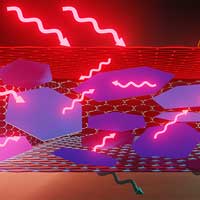 Any working electronic device is the source of electromagnetic (EM) radiation. Device miniaturization and a consequent increase in the heat and electromagnetic (EM) wave emission in the electronic systems make the simultaneous heat management and electromagnetic interference (EMI) shielding crucially important. New research shows that the extremely high thermal conductivity of graphene and good electrical conductivity, even without the energy band-gap, make graphene promising for EMI shielding and thermal management applications.
Any working electronic device is the source of electromagnetic (EM) radiation. Device miniaturization and a consequent increase in the heat and electromagnetic (EM) wave emission in the electronic systems make the simultaneous heat management and electromagnetic interference (EMI) shielding crucially important. New research shows that the extremely high thermal conductivity of graphene and good electrical conductivity, even without the energy band-gap, make graphene promising for EMI shielding and thermal management applications.
Sep 28th, 2020
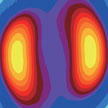 Researchers have provided an example of on-demand control of quantum phenomena to design the quantum materials. By state-of-the-art quantum mechanical simulations, they find that a two-dimensional transition-metal ditelluride, MoTe2, can realize a structural phase transition from the semiconducting phase to the topological phase triggered by photoexcitation of carriers alone. The sub-picosecond phase transition can be controlled by varying the laser wavelength. The research is inspired by the classical phase transition theory proposed by Lev Davidovich Landau and Rudolf Ernst Peierls.
Researchers have provided an example of on-demand control of quantum phenomena to design the quantum materials. By state-of-the-art quantum mechanical simulations, they find that a two-dimensional transition-metal ditelluride, MoTe2, can realize a structural phase transition from the semiconducting phase to the topological phase triggered by photoexcitation of carriers alone. The sub-picosecond phase transition can be controlled by varying the laser wavelength. The research is inspired by the classical phase transition theory proposed by Lev Davidovich Landau and Rudolf Ernst Peierls.
Sep 14th, 2020
 MXenes move nanotechnology from using a few 'wonder materials' to manipulation of hundreds and even thousands of 2D building blocks to assemble designer materials and devices. Those materials can contribute to solving the key problems in the fields of energy (generation, harvesting, storage), water (desalination, purification), food (longer storage, sensing of degradation/bacteria), environment (clean air and water) and medicine (treatment, diagnostics, artificial organs).
MXenes move nanotechnology from using a few 'wonder materials' to manipulation of hundreds and even thousands of 2D building blocks to assemble designer materials and devices. Those materials can contribute to solving the key problems in the fields of energy (generation, harvesting, storage), water (desalination, purification), food (longer storage, sensing of degradation/bacteria), environment (clean air and water) and medicine (treatment, diagnostics, artificial organs).
 Subscribe to our Nanotechnology Spotlight feed
Subscribe to our Nanotechnology Spotlight feed





